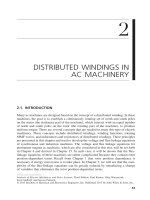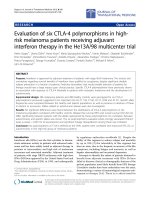Topic 4 inductance in AC circuits topic a4
Bạn đang xem bản rút gọn của tài liệu. Xem và tải ngay bản đầy đủ của tài liệu tại đây (87.91 KB, 18 trang )
Solve problems in single and threephase low voltage circuits
Part A
Topic 4: Inductance in
AC Circuits
Inductance in AC Circuits
Inductive Component
–
–
Any device that consists of a conductor formed
into a coil consisting of many turns, normally
wound around some form of iron core.
An inductive component’s function is to set up
(and store) energy in an electromagnetic field.
Inductance in AC Circuits
Key Characteristic
–
–
–
An inductive component will ACT TO OPPOSE A
CHANGE IN CURRENT
It achieves this by setting up a self-induced emf to
either oppose an increase in current, or resist a
decrease in current.
How strongly it does this is indicated by the coil’s
INDUCTANCE, symbol L, measured in Henries
(H)
L
Inductance in AC Circuits
Effect in an AC circuit
–
–
Since the current in an AC circuit is continually
changing (ie alternating between positive flow and
negative flow), an inductive component in an AC
circuit continually acts to oppose the change in
current.
As a result, the inductive component produces a
constant opposition to the flow of alternating
current.
Inductance in AC Circuits
This opposition to alternating current flow is
called INDUCTIVE REACTANCE.
XL = 2π ƒ L
Where:
–
XL is the inductive reactance in Ohms (Ω)
2π is a constant
– ƒ is the frequency in Hertz (Hz)
– L is the inductance in Henries (H)
–
Inductance in AC Circuits
Important!
–
–
INDUCTIVE REACTANCE is an opposition to
current flow like RESISTANCE, but it is NOT the
same as resistance, even though both are
measured in Ohms.
As a result, INDUCTIVE REACTANCE and
RESISTANCE can NOT be simply added to find
the total opposition to current flow in a circuit.
Inductance in AC Circuits
Key Advantages
–
–
Ability to store energy in the form of an
electromagnetic field
Ability to limit the flow of AC current to a low value
WITHOUT consuming a large quantity of power
(not heating excessively), unlike a resistor.
Inductance in AC Circuits
Examples of Inductive Components
–
–
–
–
–
–
Transformer windings
Motor windings
Ballasts for discharge lighting
Solenoids / Contactor coils
Fault current limiting devices (surge arrestors)
Filter and tuning circuits
Inductance in AC Circuits: Ohm’s Law
VL
VL
L
IL
IL
XL
VS
ƒ
Simple Inductive Circuit
Ohm’s Law – Inductive component
Inductive Reactance: Exercises
L=?
L=0.25H
IL=7.32A
IL=?
VS=230V
VS=230V
ƒ=50Hz
ƒ=50Hz
Q1. Determine:
Q2. Determine:
Inductive reactance XL, and
Inductive reactance XL, and
Current though inductor IL
Inductance of inductor L
Inductive Reactance: Exercises
A 230V, 50Hz AC supply is to be applied to a
fluorescent light fitting. If the current for the
lamp needs to be limited to 0.8A max,
determine the appropriate value of
inductance required by the ballast.
Inductance in AC Circuits: Inductance
in Series and Parallel
L1
L2
VS
ƒ
L1
L2
IS
VS
ƒ
Inductive Reactance in Parallel
Inductive Reactance in Series
X L Total= X L1+X L2+…
1
X L Total
= 1 + 1 +…
X L1 X L2…
Series Inductive Circuit
VL1
VL2
Kirchoff’s Voltage Law
L1
L2
•The ‘sum’ of the voltage drops in
the circuit will equal the supply
voltage
Vs = VL1 + VL2+…
VS
ƒ
[Purely Inductive circuit only]
Parallel Inductive Circuit
IL1
IL2
L1
L2
IS
Kirchoff’s Current Law
•The ‘sum’ of the currents
entering a junction will be equal to
the sum of the currents exiting the
junction.
VS
Is = IL1 + IL2+…
ƒ
[Purely Inductive circuit only]
Inductance in AC Circuits: Exercises
L1=0.25H L2=0.1H
IL1 L1=1.6H
L3=0.2H
IS
IL2 L2=2.4H
VS=230V
ƒ=50Hz
Determine:
•XL Total
•IS
•VL3
IS
IL3 L3=1.2H
VS=230V
ƒ=50Hz
Determine
•XL Total
•IS
•IL2
Inductance in AC Circuits: Exercises
Q1 Answers: Series
–
XL1 = 78.54 Ω
–
XL2 = 31.42 Ω
–
XL3 = 62.83 Ω
–
XL Total = 172.79 Ω
–
IS = 1.33 A
–
VL3 = 83.6 V
Inductance in AC Circuits: Exercises
Q2 Answers: Parallel
–
XL1 = 502.7 Ω
–
XL2 = 754.0 Ω
–
XL3 = 377.0 Ω
–
XL Total = 167.6 Ω
–
IS = 1.37 A
–
IL2 = 0.305 A
Review
At this stage, you should have a clear understanding
of inductance in AC circuits, including:
–
–
–
–
–
Understand the concept of inductive reactance;
Understand the application of Ohm’s Law to inductive
circuits;
Understand and be able to apply Kirchoff’s Voltage law to a
purely inductive circuit;
Understand and be able to apply Kirchoff’s current Law to a
purely inductive circuit;
How to make calculations involving V, I, and XL in
series/parallel circuits.









